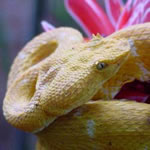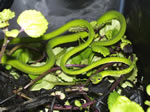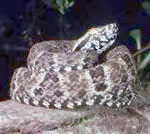![]() Boa Constrictor (Boa constrictor )
Boa Constrictor (Boa constrictor )
 The
habitat is from the Amazon rainforest north to Mexico and south to Argentina,
Cuba, Madagascar, and other parts of world. They live in the canopy and understory
layer. It's diet is rats, lizards, chickens, many other mammals, and birds.
It's enemies, when young, are birds and humans.
The
habitat is from the Amazon rainforest north to Mexico and south to Argentina,
Cuba, Madagascar, and other parts of world. They live in the canopy and understory
layer. It's diet is rats, lizards, chickens, many other mammals, and birds.
It's enemies, when young, are birds and humans.
Many species are very attractively marked. The spots on the boa help tell
its age. A captive boa was recorded to have lived over 35 years. They smell
with their tongues and hear through ground vibrations. Some species of boas
live in families, but we are not real sure of the structure. Most boas are
between 6.5 and 13 feet in length. The boa "constricts" its food.
They will wait for days near their prey's home, waiting for the perfect time
to ambush it. They are very "choosy" about their food. Their teeth
are sharp and they usually "sink" them into their prey just before
constricting. They swallow the prey whole by using a system of ligaments and
muscles (cartilage) in its jaws. Their eggs develop in their stomach and boas
give birth to live young. They do not like the water and are excellent tree
climbers.
![]() Crocodile(Crocodilia)
Crocodile(Crocodilia)
 The
habitat is South America as well as many other parts of the world. In Quintana
Roo they only appear in the natural park Sian Ka'an. They always live near
water. It's diet is fish, birds, other reptiles and mammals. It's enemies
are poachers (humans), and in South America, large anacondas.
The
habitat is South America as well as many other parts of the world. In Quintana
Roo they only appear in the natural park Sian Ka'an. They always live near
water. It's diet is fish, birds, other reptiles and mammals. It's enemies
are poachers (humans), and in South America, large anacondas.
Many species of crocodiles are endangered. Crocodiles lay still for hours
to attack prey. They drowns the prey and then eat it.
It takes 4 months for it's eggs to hatch. All crocodiles have at least 60
strong teeth. Freshwater crocodiles are smaller than saltwater crocodiles.
The freshwater crocodile has a pointer snout. Some crocodiles lie with their
mouths open and allow birds to safely pick food particles and parasites from
their teeth and gums. Crocodiles are one of the most intelligent reptiles.
Their tail is longer than their body. Some that live in the wild can live
to be over 100 years old.
![]()
![]() Eye-lash viper (Bothriechis schlegelii)
Eye-lash viper (Bothriechis schlegelii)
 The
eye-lash viper (see enlarged scales above eye). This common viper is found
perched in the vegetation, and can be quick to bite (most snake bites in the
Costa Maya are by this snake). Several morphs can be observed, including all
grey-brown, mossy green, and golden (oropel).The best known venomous canopy-dwelling
snake is the eye-lash viper of the New World which exists in several different
color forms including yellow, green, olive, and orange. The eyelash viper
is so named for the presence of small horned scales above the eye. This snake
can be found in the bushes and vegetation and should be avoided. Although
the bite is seldom fatal to humans it is very painful and will cause extreme
sickness and even death in some cases.
The
eye-lash viper (see enlarged scales above eye). This common viper is found
perched in the vegetation, and can be quick to bite (most snake bites in the
Costa Maya are by this snake). Several morphs can be observed, including all
grey-brown, mossy green, and golden (oropel).The best known venomous canopy-dwelling
snake is the eye-lash viper of the New World which exists in several different
color forms including yellow, green, olive, and orange. The eyelash viper
is so named for the presence of small horned scales above the eye. This snake
can be found in the bushes and vegetation and should be avoided. Although
the bite is seldom fatal to humans it is very painful and will cause extreme
sickness and even death in some cases.
![]() Green Vine Snake (Oxybelis fulgidus)
Green Vine Snake (Oxybelis fulgidus)
 The
green Vine snake lives in tropical forrests. It's diet is lLizards
and frogs. The size is approx. 5 feet or more in length (150 cm). It lays
small clutches of eggs and lives at least eight years in captivity. Vine snakes
are incredibly slender and next to impossible to see when coiled loosely in
a bush. They are mildly venomous and rear-fanged species.
The
green Vine snake lives in tropical forrests. It's diet is lLizards
and frogs. The size is approx. 5 feet or more in length (150 cm). It lays
small clutches of eggs and lives at least eight years in captivity. Vine snakes
are incredibly slender and next to impossible to see when coiled loosely in
a bush. They are mildly venomous and rear-fanged species.
![]() Jumping Viper
Jumping Viper
 The
Jumping viper has a stocky body. Its ground color varies from brown to gray
and it has dark brown or black dorsal blotches. It has no pattern on its head.
It is chiefly a nocturnal snake. It comes out in the early evening
hours to feed on lizards, rodents, and frogs. As the name implies, this species
can strike with force as it actually leaves the ground. Its venom is hemotoxic.
Humans have died from the bites inflicted by large jumping vipers. They often
hide under fallen logs and piles of leaves and are difficult to see. It is
found in rain forests, on plantations, and on wooded hillsides. It's length
is average 60 centimeters, maximum 120 centimeters.
The
Jumping viper has a stocky body. Its ground color varies from brown to gray
and it has dark brown or black dorsal blotches. It has no pattern on its head.
It is chiefly a nocturnal snake. It comes out in the early evening
hours to feed on lizards, rodents, and frogs. As the name implies, this species
can strike with force as it actually leaves the ground. Its venom is hemotoxic.
Humans have died from the bites inflicted by large jumping vipers. They often
hide under fallen logs and piles of leaves and are difficult to see. It is
found in rain forests, on plantations, and on wooded hillsides. It's length
is average 60 centimeters, maximum 120 centimeters.
![]() Fer De Lance (Bothrops atrox)
Fer De Lance (Bothrops atrox)
 The
snake can grow to a length of eight feet, but most only get about four to
five feet long. The body is brown or dark gray with a pattern of black-edged
diamonds running down the body. Its evil reputation is enhanced by its long
hollow poison filled fangs. The fangs carry venom from special glands into
the victim's body the way a hypodermic needle injects serum. Its venom is
very potent and accidents are quite common because its habits bring it into
contact with man. The fer de lance is feared by agricultural workers as they
often encounter them while they work clearing field for planting. The fer
de lance also has an unpleasant habit of coming out at night to lie on warm
roads and footpaths.
The
snake can grow to a length of eight feet, but most only get about four to
five feet long. The body is brown or dark gray with a pattern of black-edged
diamonds running down the body. Its evil reputation is enhanced by its long
hollow poison filled fangs. The fangs carry venom from special glands into
the victim's body the way a hypodermic needle injects serum. Its venom is
very potent and accidents are quite common because its habits bring it into
contact with man. The fer de lance is feared by agricultural workers as they
often encounter them while they work clearing field for planting. The fer
de lance also has an unpleasant habit of coming out at night to lie on warm
roads and footpaths.
Fer de lances feed on arthropods and lizards when young, but are equipped
to locate and kill mammals and birds. The adult snakes measuring five feet
feed on small animals such as opossums, frogs, lizards, small snakes and rodents.
Their search for prey once again brings them in contact with man, because
they frequent old dwellings and outhouses which are usually infested with
rodents. Fer de lance snakes ambush their prey. The sense of smell is always
a dominant sense. The vomeronasal organ, found in the palate, analyzes the
odors collected by the tongue outside the mouth which helps them locate their
prey.
The young are born alive in litters of 60-80 about one foot long. They are born with the venom apparatus fully developed and are dangerous from birth. The number in a litter and the size depends on the size of the mother. A six foot fer de lance bears young one foot long.
The large numbers of fer de lances in one litter are usually cited as the explanation for the species being so common. This might be true, but the number of eggs or babies that an animal produces is usually proportional to its mortality rate, so numbers entering the population balance the numbers lost. The fer de lance is probably common because it is adaptable and can live in a variety of habitats.
A fer de lance can defend itself against many predators by its poisonous
bite, and by rapidly vibrating its tail when disturbed. It does not have a
rattle like its relatives the rattlesnake but the vibrating tail rustles against
the leaves and presumably acts as a deterrent. The snake can grow to to a
length of over 2.5 meters or 8 feet.